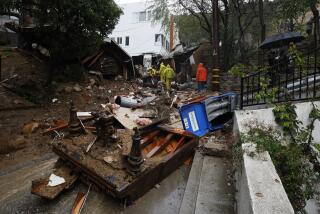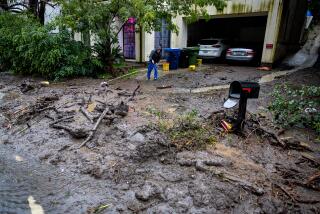Sandy’s receding waters reveal more deaths; boys swept from car
The number of dead from super storm Sandy continued to increase on Thursday as floodwaters slowly receded back to the sea, exposing bodies including two small boys killed on Staten Island, N.Y.
As officials around the country coped with cleaning up and accounting for the missing, the death toll climbed to about 80. New York City announced there had been 38 reported deaths, at least 17 from Staten Island, the outermost of the city’s boroughs.
The children were swept out of a car driven by their mother, Glenda Moore, when the vehicle was overtaken by a tidal surge Monday night, hours before Sandy made landfall in New Jersey. As the storm approached, it carried hurricane-force winds hundreds of miles in all directions and pushed walls of water into low-lying coastal areas in record-setting surges. The boys, Connor, 4, and Brandon, 2, were officially identified days later, officials said Thursday.
PHOTOS: Super storm Sandy | Before and after the storm
In addition, an elderly couple, previously reported missing, were found dead Thursday in their car on Staten Island. Rescuers were predicting that the death toll could rise as recovery efforts continued.
Even as the toll grew, recovery efforts moved to center stage: moving people and commodities around transportation-challenged regions still soggy and salt-crusted by seawater; bringing food, water, gasoline and electricity to badly damaged areas; and the perhaps the politically charged question, how to pay for it all.
VIDEOS: East Coast hit by deadly storm
“New York is starting to build again,” Mayor Michael R. Bloomberg told reporters at his daily news briefing.
Subways, railroads and buses started to roll and even limited service cheered many. Cars once again clogged roads despite long lines for fuel in New Jersey, where gasoline stations had to shut for lack of fuel or electricity to run the pumps. The third major airport reopened in New York and flights were resuming, albeit slowly. Bloomberg announced that parks and playgrounds would reopen by 8 a.m. Saturday, and public school classes would resume Monday.
Officials were distributing supplies including emergency rations and water. Utilities such as Consolidated Edison distributed dry ice. Help was coming from Southern California and even some foreign countries such as Mexico, emergency officials said in a conference call with reporters.
“There are people making the transition from shock to the real world of how you get food and so forth, and we will do all we can to help them,” Bloomberg said. He reassured residents that the city’s water was safe.
“Feeding and shelter are going to be our primarily focus as we move into the next 24, 48 hours,’’ Charles Shimanski of the American Red Cross told reporters. “This is a frustrating time for people as they wait without power.... We want folks to know we’re doing everything possible to make sure communities have the help that they need.”
More than 7,000 people spent Wednesday night in Red Cross shelters in nine states, he said.
“You’ve got survivors out there; they don’t care how much stuff you have in staging. They don’t care how many press releases you’ve issued. All they want to know is when is my power coming back on and can you help me get a place to stay.” FEMA Administrator Craig Fugate said on the conference call. “I’m not going to be satisfied until everybody who needs housing assistance has that assistance. I’m not going to be satisfied until we have got the resources in the hands of survivors. And I’m not going to be satisfied until the power is back on.”
New York Gov. Andrew Cuomo said in a Twitter message that as of 9 a.m. Thursday more than 1.58 million New Yorkers were without electricity, including more than 600,000 in the New York City area and more than 700,000 on Long Island. Nationwide, more than 4 million customers were without electricity, compared with the 8.5 million who lost power in the storm.
ConEdison said it had restored power to more than 225,000 customers since the storm ended but did not expect to have full recovery until the end of next week. The utility has said that power for customers whose lines are underground will be restored sooner. Lower Manhattan is expected to be substantially back within the next few days.
Estimates for the long-term tab to rebuild and to cover losses range from $5 billion to $50 billion, and perhaps more depending on what is counted. Immediate and temporary help, however, is on the way.
The federal government will pay 100% of the costs to help get public transportation and power restored to parts of New York and New Jersey, Fugate said. In previous disasters, he said, FEMA generally paid states for 75% of those costs and in some cases as much as 90%.
Fugate said President Obama, who toured some of the devastation with New Jersey Gov. Chris Christie on Wednesday, approved local requests to fully pay for emergency transportation and power grid repairs for 10 days. He did not give any estimates of how much that will cost.
But the infusion is just temporary and it is too soon to know how much the federal government will reimburse local governments for all recovery costs.
ALSO:
After super storm Sandy, no hot showers but also no crime
Officials: Amid Sandy devastation, New Jersey needs more help
Penn State ex-president charged in Sandusky sex abuse coverup
More to Read
Start your day right
Sign up for Essential California for news, features and recommendations from the L.A. Times and beyond in your inbox six days a week.
You may occasionally receive promotional content from the Los Angeles Times.








